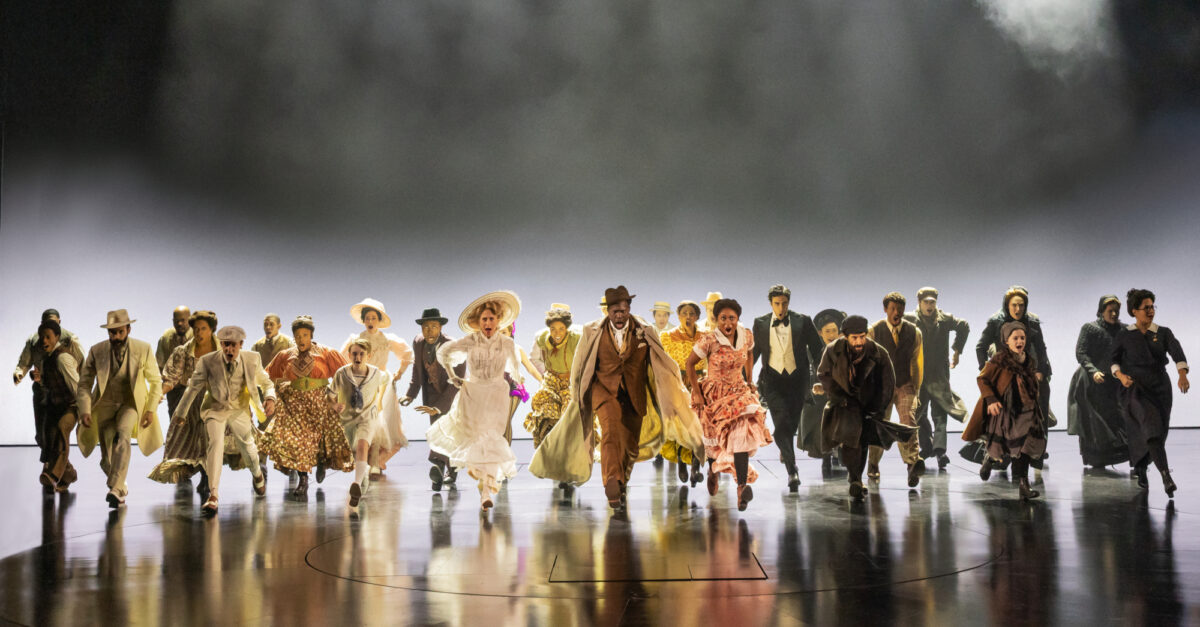If you’ve ever been to gamescom, you’ll know the German city of Cologne isn’t adverse to lavish displays of excessive meat. Sizzling sausages the length of your arm curl around heaps of sauerkraut, and sweating hulks of pig known as pork knuckles sit alongside mountains of mashed potato. But it wasn’t until I sat down to play Clive Barker’s Hellraiser: Revival that I truly saw the limits of just how meaty this year’s convention could get for me.
I saw almost-dead humans being chopped up for cult-like rituals, people strung from ceilings with their backs opened up to form fleshy wings, and even at one point looked down to catch a look at my character’s fully-modelled, flopping appendage. Yes, despite all the gruesome violence on display, weirdly, full-frontal nudity is still the most shocking thing to see in a video game in 2025. But what actually is Hellraiser: Revival in terms of a playable experience? Well, let me walk you through the 45-minute demo I went hands-on with, and explain how it puts a sadistic spin on first-person survival horror.
Revival may be many things, but I highly doubt the word “subtlety” was written large on the whiteboard when developer Saber Interactive conceived it. It opens with a fully laid bare sex scene set against a stormy backdrop that barely masks the screams of pain and pleasure from its participants. Lightning strikes as needles are plunged into a man’s body, his partner asking for a similar level of sadomasochism as she sits atop him — this isn’t her first rodeo, so to speak. Before I get too much into the realms of just writing soft porn, let’s cut to the chase and introduce an object from an entirely different realm: the Lament Configuration. This golden puzzle box is synonymous with the 1980s film series on which this project is based, and happens to be the next toy our couple (foolishly) choose to play with. The man angles it so as to use its sharp edges to make incisions down the woman’s back, giving her what she desires, but with an unfortunate side-effect: the opening of a portal to another dimension.
Otherworldly pleasure is what the Cenobites are all about. A group of disfigured and unsettling individuals led by the iconic Pinhead, they swiftly lure our protagonist’s girlfriend into their misty, stonewalled prison fortress, and so the stakes are set. What will follow is one man’s desperate and depraved journey to rescue the woman he loves from a group of interdimensional deviants with a penchant for leather. Just a standard weekday, really (I was witnessing all of this at 10am on a Friday after a week of little sleep and a healthy amount of German beer, just so you know).
I finally took control of this unfortunate soul and wandered around the corridors of this other place, with its looping passages inflicting a good sense of disorientation. It’s almost impossible now not to think of Hideo Kojima’s P.T. when face-to-face with a scenario like this, and while Hellraiser’s demo never comes close to recreating that specific brand of tension, I did feel thrown into this world effectively. Clanking chains punctuated a screeching wind, ominous silhouettes waited at the end of passages, and weird monsters popped out of my peripheral vision to remind me that I was never alone here. For all of its not-so-polished mechanics and familiar genre tropes — we’ll get onto those later — Revival is certainly off to a strong start in terms of creating an oppressive tone and a place I wanted to escape from as quickly as possible. Thankfully, I soon make my way out, but then the demo skips ahead in the story a little, and I find myself yearning for those prison corridors once again as I’m thrown firmly out of the frying pan and into the fire.
With little context given, I was now strapped to a chair; my wrists nailed into its wooden armrests, and my left arm stitched into my stomach to keep my reach at a minimum. It is then that I pulled the camera down to see that I was indeed fully naked, our hero’s full manhood on display, but, thankfully, untouched by my captors – I can only assume a certain princely piercing was acquired out of choice. All of this self-inspection takes place while a charismatic cult leader paces around the small cell and inquires about the whereabouts of the Lament Configuration. It becomes quickly apparent that it is much more than a sex toy to him, and, in fact, the key in his plan to summon the Cenobites — the creatures that his cult worships.
Thankfully, he soon leaves me to ponder my predicament, and I make my escape. In a Saw-like affair, I cleave the nails from my wrists and then use their rusted points to cut the threads holding my arm to my stomach. Then, as is tradition in all good survival horror, I craft a bandage using some collected cloth and alcohol and apply it, restoring my health meter to a reasonable level. It’s from this point on that I realise just what Hellraiser: Revival is: a Resident Evil game in all but name. I spend the next section of the demo quietly crouching around the dungeon bowels of a nightclub, mostly avoiding its patrols until I’m handed a weapon of my own. The knife I find slots nicely into a grid-like inventory system alongside some medicinal herbs, and I use it to quietly take down my first member of the Cenobite fan club with a stealth kill.
I’m then tasked with taking one down face-on, though, and it’s when going toe-to-toe with my aggressors that I find Hellraiser shifts into a different gear. Its first-person melee combat becomes slightly more involved than anything seen in Capcom’s horror catalogue, complete with light attacks, heavy attacks, blocks, and dodges. On the surface, not all that original, but it adds an extra wrinkle when faced with armored foes. You see, sharp and serrated weapons such as knives and machetes are effective against flesh, but in order to make your enemy bleed, you’ll need to break through their protection using blunt weapons such as a pipe or bat. This adds a welcome layer that I’ll admit was unexpected, but a welcome surprise in a demo that had so far been very by-the-numbers.
This melee weapon system, combined with dingy rooms and masked aggressors, reminds me of 2003’s Manhunt, and I do wonder if Saber is aiming for the same kind of shock factor and controversy storm Rockstar whipped up back then. The vomit bags sitting next to the monitor in case I needed them certainly felt like the sort of publicity stunt aiming to invoke such a reaction.
Yes, Hellraiser: Revival is particularly violent, and seemingly relishes it as much as its NPCs do when they yelp in pleasure as you split their flesh. Human meat sculptures line the corridors of the cult lair, forming dioramas reminiscent of the worst that Bryan Fuller’s Hannibal had to offer. Corpses have been rearranged into twisted pinwheels and nailed onto walls, and internal organs stacked like the most depraved of totem poles. It’s undeniably shocking at times, and if you’re not a fan of gore, this really isn’t the way you’ll want to spend your time. Maybe I’m just desensitized by it all, though, as after a while, I found myself looking at another bleeding aberration and thinking to myself, “I wonder if they’ve stuffed the heart or the liver in their mouth this time”.
The aspects I found much more engaging were spent in the other dimension, the one where Cenobites instill fear as opposed to the debauched depths of the human mind. The highlight of the demo was when I was chased by The Chatterer — one of Pinhead’s most loyal sidekicks whose vibrating teeth genuinely sent a shiver down my spine as he pursued me. I had to sprint through randomly closing doorways and slide under spikes and hooked chains in order to escape his grasp and his hungry gnashers. It was a genuinely tense slice of survival horror and something I hope to see more of in the final game. When it’s leaning into Hellraiser lore and creating a powerful sense of dread, you can really see Clive Barker’s hand reaching over the game. It’s a shame his unique brand of horror doesn’t feel as present back in the real world.
My demo ended with a couple of fairly simple puzzles that included reaching into the guts of two different corpse displays to retrieve two halves of a key, and pressing down on four nails sunk into a skull in the right order to obtain yet another key. They were a change of pace, but hardly riveting in their execution. The same can be said for Revival’s gunplay, which lacked punch to say the least. I took out a few goons thanks to a few pistol shots to the head, but didn’t get the sort of trigger feedback I’d desire from a competent shooter. Ammo was handed to me fairly liberally, so I have my fears that Revival may lean closer to the “action” side of survival horror more than I’d ideally like, and ultimately feel more Resident Evil 4 rather than the RE 7 it initially looks to be taking inspiration from. I found the melee system much more engaging and would like this to be the most prevalent manner of conflict in the full game, rather than the entire experience devolve into a first-person shooter that has you gunning down wave after wave of grunts.
When committing to its own style and embracing Hellraiser’s unique look and tone, Revival is a strong and shocking take on the survival horror genre. Its apparent influences are fully on display as much as the countless pieces of corpse art that flank its hallways, from Resident Evil to Manhunt, with even a dash of Condemned thrown into the mix. It’s when it leans harder into the combat side of these inspirations that I begin to vibe with Hellraiser less, though, as well as when its creepy, leather-laden tone is replaced by sequences bordering on torture porn. If it’s aiming to shock, Hellraiser: Revival is certainly looking to be on target. If it’s aiming to bring something fresh to survival horror, I have my reservations for now.
Simon Cardy is a Senior Editor at IGN who can mainly be found skulking around open world games, indulging in Korean cinema, or despairing at the state of Tottenham Hotspur and the New York Jets. Follow him on Bluesky at @cardy.bsky.social.
Source link

:max_bytes(150000):strip_icc()/ragtime-14-101525-64097cb365924dc193c336091c79ab84.jpg)
